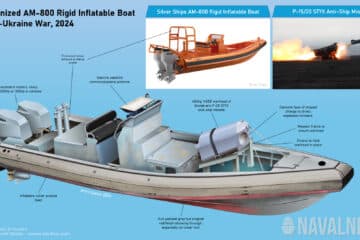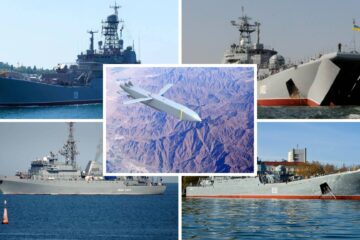The threat of sea mines reportedly first appeared after an Estonian general cargo ship sank after colliding with a sea mine off the coast of Odessa. Four crew members are still missing after the explosion.
Although there are not enough reports and explanations about this event, the status of the ship was spotted on AIS (automatic identification system) just before the incident at anchor. As a result, it was determined that the explosive charge of an anchored sea mine had come loose from the mooring for some reason and hit the ship while it was drifting. However, the authorities did not give any explanation about this event to clarify the incident.
The Horrifying Alert

Two weeks after this incident, on March 18, the Russian coastal station Novorossisiyk issued a disturbing NAVTEX message (Navigational telex – an international service providing navigational and meteorological warnings and forecasts) stating that mines anchored by Ukrainian naval forces near the port of Odesa had loosened their chains due to stormy weather. The Novorossisiyk station claimed that about 420 sea mines were floating on the water and accused Ukraine of violating the provisions of the 1907 Hague Convention.
On the same day, the port of Sochi sent a warning to shipowners and masters in the region about the danger of an explosion of Ukrainian naval mines drifting in the Black Sea.
After the danger report from the Russian side, the Turkish NAVTEX station Samsun issued a warning to the mariners referring to the mine danger broadcasted by Russia.

Floating sea mine spotted in Turkish waters

After Russia issued the NAVTEX message about the possible sea mines, the main concern of Turkish analysts was the possible drift of the floating mines in the approaching waters of the Istanbul Strait (or Bosphorus) due to the tense commercial traffic. Turkish officials repeatedly stated that the Turkish Navy had taken the necessary measures.
At 9:30 a.m. local time on March 26, a MILCO (mine-like contact) was detected by a Turkish fishing vessel in the anchorage area near the entrance to the Strait of Istanbul, and the MILCO’s position was reported to the Turkish Coast Guard. Coast Guard vessels proceeded to the area and established a security zone to prevent unwanted entry. Subsequently, a Turkish Navy-affiliated underwater defence team (UDT) secured the MILCO on shore and began an investigation.
In the afternoon, the Turkish Defence Minister, Hulusi Akar, spoke to the state-owned Anadolu Agency that the mine-like object is an aging sea mine:
“The sea mine was defused by the Turkish Navy’s UDT shortly after it was reported. We are in contact with the Russian and Ukrainian governments on this matter. Our Navy and Coast Guard have taken the necessary measures to ensure the safety of maritime traffic. The Turkish Navy is on alert in this matter and is closely monitoring activities in the area.”
Hulusi Akar, Turkey’s Minister of Defence
The Turkish Navy has deployed two Aydin-class MCM vessels (visually verified by Bosphorus Observer Yoruk Isik as TCG AKCAY (M-270) and TCG AKCAKOCA (M-268)), CASA CN-235M-100 maritime patrol aircraft, and Tuzla-class patrol boat TCG TEKIRDAG (P-1207) as a measure for the further incidents.
Author’s opinion
General use of Sea Mines
Sea mines (or naval mines) are silent and (generally) passive weapons that have been used in naval warfare for more than a century. It is a relatively cheap, easy-to-use, and highly effective weapon that allows weaker naval forces to confront larger, more technologically advanced opponents. It is a “fire and forgets” weapon, secretly waiting for its victim to unknowingly cross its path (often for many years). But the mines poses threat to everyone after deployment.
Mines also have a tremendous psychological impact. The mere possibility that mines have been laid in a body of water is enough to bring maritime operations to a halt and effectively prevent or slow access to a particular body of water or strategic chokepoint. Thus, a mine does not even have to blow something up to accomplish its task.
So, it will not be wrong to say that these mines A2AD (Anti-access/Area Denial) instruments for less capable countries to prevent the enemy from using their warships in critical areas or straits. This is referred to in naval warfare literature as “defensive mining.”
But countries cannot use sea mines indefinitely. Once a country mines a maritime zone, it must announce this to the world to avoid unwanted accidents. But these mines must hold their position after they are laid because if they float on or under the water, they are very dangerous not only to merchant traffic but also for warships. After drifting mines caused many civilian casualties in the Russo-Japanese War of 1904-1905, the use of drifting mines is prohibited under the venerable 1907 Hague Convention because they are indiscriminately targeted at ships.
Drifting Mines in Russo-Ukraine war: What can be behind the curtain?
Without any doubt, the drifting mines are a serious threat to any ship. But there are some unclear issues about Russia’s NAVTEX announcement and the drifting mines.
Although it seems reasonable for Ukraine to lay sea mines to prevent Russian warships from approaching its main ports, it seems unlikely that such a measure could be carried out. Given that the Russian Black Sea Fleet has dominated the northern Black Sea since the beginning of the war, daily OSINT reports suggest that more than a few Russian warships have been patrolling the area continuously.

Laying hundreds of sea mines takes a long time because it’s a delicate activity, and Ukrainian ships cannot lay mines while the Russian fleet monitors the area 24 hours a day. Other methods of laying mines are aircraft or submarines, but even these are impossible as Ukraine doesn’t have these capabilities. Perhaps Ukraine laid a few mine lines quickly and carelessly with a tug or other small ship, but laying 420 mines seems almost impossible.
Another problem is the number of mines. How did Russia count these mines, and how can they be sure? In the fog of war, it is very difficult to get the true information because of the false flags. Therefore, visually verified information is invaluable in this war. As a technologically advanced and powerful country, Russia must verify such a claim with visual sensors and make the video available to the public to convince the international community.
The first casualty, when war comes, is truth…
Hiram W Johnson, ex- US Senator (1866-1945)
It is also interesting that the mines reached the Bosphorus from Odessa in such a short time. Although there is a current from the Danube to the Bosporus, it seems unlikely that a mine that drifted in such a short time could have traveled 360 nautical miles. The detection of mines in the waters of the Istanbul Strait just a week after Russia’s NAVTEX notification adds to the suspicion on this issue. Even in a scenario with continuous north winds and currents in the region (which has not been the case in the last month), a sea mine should take about 20-25 days drifting to arrive in Istanbul from Odessa.
Looking at the general map of the Black Sea shown below, a mine that began to drift off Odesa and broke its chain would still have to threaten the Romanian and Bulgarian coasts before reaching Istanbul.

Moreover, the fact that the mine drawn from the sea is clean and not rusty strengthens the opinion that this mine was not long in the sea. This is because the mines that lie in the sea for a long time become relatively rusty and a lot of algae etc. remain attached to them.
In this context, the curious question arises: who owns these mines? Who let these mines loose on the Black Sea? Since the beginning of the war, the launching of this operation by Russia, whose legitimacy was problematic, was not accepted by the international community. In this case involving the banned floating mines, could Russia have taken such a step to put Ukraine in a difficult position on the international stage? After all, Russia’s improved Kilo-class submarines can deploy up to 24 sea mines, and there are currently four or five Russian submarines on patrol in the Black Sea, while Ukraine does not have this capability. Of course, it’s not easy to answer “yes” or “no” to this question.
On the other hand, the silence of Ukraine on this issue is disturbing as well. If there is Russian propaganda here, the Ukrainian authorities should make a statement whether they carried out mining operations and promulgate the coordinates.
Regardless of who released these floating mines in the Black Sea, they pose a threat, especially to civilian shipping and fishery. While freedom of the sea has been affected by this war, the presence of floating mines has created a new dimension of threat to neutral countries and civilian vessels. It stands as a serious problem.






